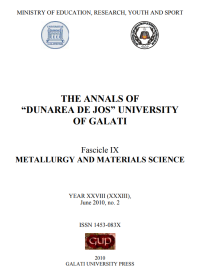Glass-Carbon Bioactive Coatings on a TiO2- Nb2O5 Substrate
Abstract
The research carried out studies the processes of coating and impregnation of non-active glass carbon coatings on TiO2-Nb2O5 substrates, intended for surgery implants for hip joint prostheses. It was found that the coating procedure implemented and the subsequent impregnation, lead to filling of the substrate’ pores with glass carbon, thus resulting in a substantial decrease of the substrate’s roughness. It was found that preliminary treatment of the substrate aiming at a formation of TiC on its surface is important for the subsequent buildup of a stable glass-carbon coating. The tribological measurements carried out show substantial decrease of the friction coefficient of vitreous carbon (VC) – hip joint, which is the prerequisite for using these coatings as surgery implants for hip joint prostheses.
Downloads
References
[2]. Pohler E. M., Unalloyed titanium for implants in bone surgery, Injury, Int. J. Care Injured, vol. 31 (2000), S-D7-13.
[3]. Marty A., Cobalt-base alloys used in bone surgery, Injury, Int. J. Care Injurd, vol. 31 (2000), S-D18-21.
[4]. Eschbach L., Nonresorbable polymers in bone surgery, Injury, Int. J. Care Injured, vol. 31 (2000), S-D22-27.
[5]. Marti A., Inert bioceramics (Al2O3, ZrO2) for medical application, Injury, Int. J. Care Injured, vol. 31 (2000), S-D33-36.
[6]. T. V. Tamaraiselvi and S. Rajeswari, Biological Evaluation of Bioceramic Materials – A Rewiev, Trends Biomater. Artif. Organs, vol. 18 (10, PP. 9-17 (2004).
[7]. P. N. De Aza, A. H. De Aza, S. De Aza, Crystalline Bioceramic Materials, Bol. Soc. Esp. Ceram. V., 44 [3] 135-145 (2005).
[8]. Sunho Oh, Namsik Oh, Mark Appleford, Joo L. Ong, Bioceramics for Tissue Engineering Applications – A Review, American Journal of Biochemistry and Biotechnology 2 (2): 49-56, 2006, ISSN 1553-346.
[9]. Bulgarian Patent, № 36107.
[10]. Bulgarian Patent, № 16834.
[11]. Bulgarian Patent, № 30527.
[12]. Bulgarian Patent, № 24996.
[13]. Bulgarian Patent, № 31847.
[14]. Jordanova M., D. Teodosiev, J. Georgiev, Composite ceramic materials based on vitreous carbon as transplantation materials in the human organism – Obtaining and structure, Acta morphologica et antropologica, vol. 6, 2001, p. 64-69.
[15]. Jordanova M., D. Teodosiev, J. Georgiev, Composite ceramic materials based on vitreous carbon as transplantation materials in the human organism – Basic structural and functional tests, Acta morphologica et antropologica, vol. 6, 2001, p. 70-75.



